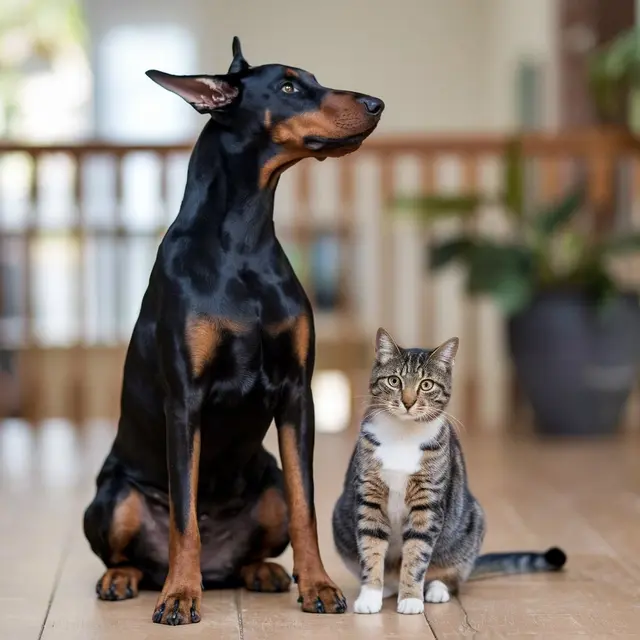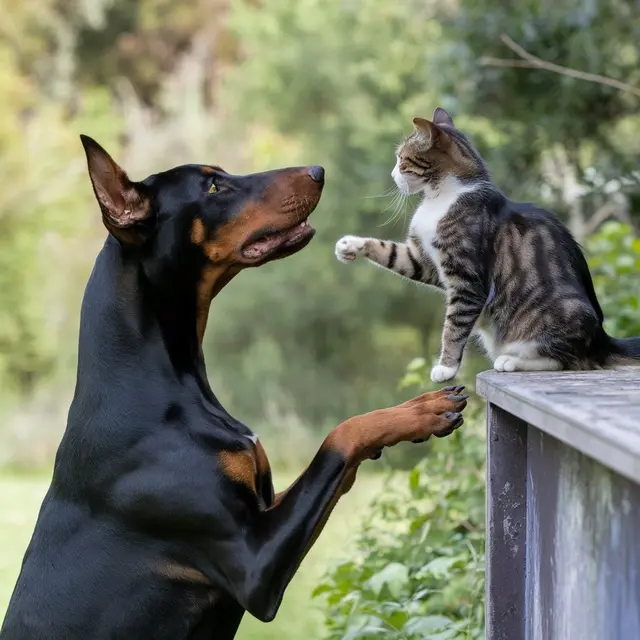🐶🐱 Are Dobermans Good With Cats?
If you’re wondering, Can Dobermans live with cats?, the answer is yes — but only under the right conditions. Dobermans are known for their intelligence, loyalty, and trainability, capable of forming peaceful or even affectionate relationships with feline companions.
However, successful Doberman and cat compatibility depends on early exposure, consistent training, and understanding both pets’ personalities.
In this guide, we’ll walk you through everything you need to know about introducing a Doberman to a cat, managing potential issues like prey drive, and ensuring a safe, harmonious multi-pet household.

🐾 Exposing Dobermans to Cats: Puppies vs. Adults
For Puppies (8–16 Weeks Old)
Early socialization plays a crucial role in helping Doberman puppies live with cats peacefully.
- Bite Inhibition: Teach gentle play using “ouch!” feedback and redirection to chew toys.
- Controlled Exposure: Let the puppy observe the cat from behind a baby gate or inside a crate, rewarding calm behavior with treats like chicken.
- Cat as a Teacher: Confident cats may naturally correct a playful pup with a warning swat (always supervise closely).
Tip: Dobermans raised around cats during the critical socialization window (3–14 weeks) are more likely to develop a relaxed attitude toward felines.
For Adult Dobermans
Introducing an adult Doberman to a cat requires more planning, especially if they have no prior experience with small animals.
- Leash Training First: Practice essential commands like “leave it” and “focus” before face-to-face meetings.
- Assess Past Experience: Ask breeders or shelters about your dog’s history with small animals or prey drive.
- Desensitize Gradually: Play cat sounds at low volume during meal times to create positive associations.
Did You Know? Even adult Dobermans can learn to live with cats successfully with reward-based training and patience.

🔍 Do Dobermans Get Along With Cats? Key Factors
Individual Dog’s Personality
Every Doberman has a unique temperament. Some dogs are naturally gentle around smaller animals, while others may display a stronger prey drive.
- Dogs with prior exposure to cats tend to adapt faster than those who haven’t.
- High-energy Dobermans benefit from structured environments and obedience practice.
Your Cat’s Confidence Level
Your cat’s personality also plays a major role in how smoothly the introduction goes.
- Confident cats often set boundaries and adjust well.
- Timid or elderly cats may become overwhelmed.
Pro Tip: Use Feliway diffusers one week before the introduction to help reduce feline stress.
Early Socialization Matters
Doberman puppies raised with cats typically develop better impulse control and understanding of feline body language.

Use treats and praise liberally to reinforce calm behavior during early interactions.
🧩 The 7 Tips for Harmonious Doberman-Cat Cohabitation
Here are seven practical tips to help your Doberman and cat live together in peace:
- Introduce Scents First
- Swap blankets or toys between pets for 3–5 days.
- Rub a towel on the cat and let your Doberman sniff it during training sessions.
- Use a Barrier for Initial Meetings
- A sturdy baby gate allows safe visual contact.
- Feed both pets near the barrier to build positive associations.
- Start Slow with Supervised Sessions
- Limit initial interactions to 5 minutes.
- If your Doberman stares intensely, redirect attention with a “look at me” command.
- Maintain a Calm Environment
- Avoid loud noises or large gatherings during introductions.
- Play soft music to help ease tension.
- Designate Separate Safe Spaces
- Cat: Install wall-mounted shelves or a catio.
- Doberman: Create a “zen zone” with a bed and puzzle feeder.
- Reward Peaceful Coexistence
- Treat both pets when they’re calm near each other.
- Example: Give your cat a lick mat while your Doberman practices a “down-stay.”
- Never Rush Unsupervised Time
- Wait 2–3 months of conflict-free interactions before leaving them alone together.

🐱➡️🐶 Step-by-Step Guide: Introducing a Doberman to a Cat
Step 1: Scent Swapping
Let both pets sniff each other’s bedding before meeting face to face. This builds familiarity and reduces anxiety.
Step 2: Controlled Visual Contact
Use a baby gate or screen door to allow visual access without physical contact. Feed both pets near the barrier to create positive associations.
Step 3: Supervised Meetings
Keep your Doberman on a leash and allow the cat to approach freely. Watch for signs of stress or aggression and keep sessions short.
Step 4: Gradual Freedom
Increase unsupervised time gradually after several weeks of calm, respectful behavior from both pets.
🎯 Obedience Training: Building Trust Between Dobermans and Cats
Training is essential for managing a Doberman’s instincts:
- “Leave It” Command: Helps curb chasing behavior.
- “Stay” and “Focus”: Reinforce self-control and attentiveness.
- Use a Leash Indoors: During the early stages, to maintain control.
- Daily Practice: Consistency is key. Use high-value treats to reward good behavior.
“A well-trained Doberman can coexist peacefully with cats,” says certified trainer Jane Doe.
😾 Managing Prey Drive and Aggression
Reduce Prey Drive Through:
- Exercise: At least 60 minutes of walking, running, or playing daily.
- Mental Stimulation: Puzzle toys, training games, and scent work.
- Redirect Focus: Use the “leave it” command when your Doberman fixates on the cat.
Recognizing Signs of Aggression
| Doberman | Cat |
|---|---|
| Stiff tail posture | Hissing |
| Whale eye (showing whites) | Arched back |
| Low growling | Pinned ears |
De-Escalation Strategies
- Stay neutral and avoid yelling.
- Use a calm “let’s take a break” cue.
- Lure your Doberman away with treats, not force.
- Reset and try again after 24+ hours, keeping interactions shorter.
Important: If aggression escalates, consult a certified animal behaviorist immediately.

❓ Frequently Asked Questions (FAQs)
Q: Do Dobermans Like Cats?
A: Many do, especially if socialized early. Their ability to bond depends on individual temperament and training.
Q: How Are Dobermans with Cats?
A: They’re typically gentle but may chase if untrained. Always supervise initial interactions.
Q: Can Dobermans Get Along with Cats?
A: Yes—with proper training and careful introductions.
Q: Can Doberman Puppies Live With Cats?
A: Absolutely. Puppies often adapt well to cats, especially with early socialization. Supervision is still crucial.
Q: How Do I Know If My Doberman Likes My Cat?
A: Look for relaxed body language, peaceful coexistence, and respect for the cat’s space.
Q: What If My Doberman Chases My Cat?
A: Redirect the behavior calmly and seek help from a professional trainer if needed.
Q: Can I Leave My Doberman Alone With My Cat?
A: Not initially. Wait until you’ve had 2–3 months of conflict-free interaction.
Q: Should I Get a Doberman If I Already Have a Cat?
A: Consider your cat’s personality and your ability to manage the introduction process carefully.
Q: Can an Adult Doberman Learn to Live With Cats?
A: Yes! Focus on reward-based training and gradual exposure.
Q: What If My Home Is Small?
A: Use vertical space creatively—cat shelves, under-bed storage for litter boxes, etc.
Q: How Long Until They Can Be Alone Together?
A: Minimum 2 months of perfect behavior. Pet cameras can help monitor early unsupervised interactions.

💬 Real-Life Success Story
“My Doberman and cat now nap together,” shares owner Mark Smith. “Patience, consistency, and lots of treats made all the difference!”
⚠️ When Dobermans and Cats May Not Work
Avoid cohabitation if:
- Your Doberman has a strong, unmanageable prey drive.
- Your cat is elderly, frail, or highly fearful.
Alternatives: Breeds like Golden Retrievers or Basset Hounds may be more naturally inclined toward feline friends.
🧘 Additional Tips for a Happy Household
Spaying/Neutering
Talk to your vet about the best timing. These procedures can help reduce hormonally driven aggressive behaviors.
Regular Exercise & Playtime
A tired Doberman is a well-behaved Doberman. Ensure daily walks, training, and interactive play.
Use of Pheromone Diffusers
Feliway products can help reduce stress in cats during the introduction period.
Creating Safe Havens
Provide your cat with elevated escape routes, cozy hiding spots, and exclusive areas where the dog cannot enter.
❤️ Final Thoughts: Harmony Is Possible
Dobermans and cats can live together in harmony—but it takes time, effort, and understanding of both animals’ needs.
Success begins with early socialization, continues with consistent obedience training, and thrives in a thoughtfully structured environment.
Remember: every pet is unique. Observe their behavior closely, intervene when necessary, and always keep a positive attitude.
With patience and care, your Doberman and cat may just become the best of friends.

📌 Want More Tips?
Subscribe to our newsletter for expert guides, product recommendations, and real-life success stories from multi-pet households!
👇 Share Your Story!
Have a Doberman and a cat living together? Tell us how they met and what helped them bond in the comments below!
Leave a Reply
You must be logged in to post a comment.